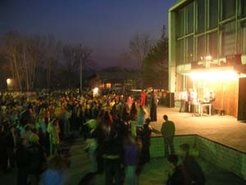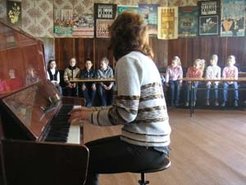The Public Sphere of Culture in Siberia: Houses of Culture in and around Novosibirsk

In my research project I examine the house of culture (dom kul’tury), an institution that existed and continues to exist throughout Siberia, the former USSR, and in many other post-socialist countries. I am interested in the social significance of this institution for its respective communities, the ways in which local houses of culture operate on a daily basis, and the prospects for these institutions in the context of cultural policies in contemporary Russia.
Houses of culture have thus far rarely been the subject of social-science research, even though they served as the central sites and instruments for prosveshchenie (“enlightenment”), self-improvement and self-expression, both of the individual and the community as an entity. In many places, they continue to serve this purpose. Free-time activities such as those rehearsed and performed at the house of culture generally have positive associations: beauty and pleasure, solidarity and community, and the excitement of special events (as opposed to the humdrum of everyday life).

However, the activities in the house of culture represent not only entertainment but also the considerable effort that goes into the advancement of the self as member of society. While the educational and civilising mission of the house of culture was explicit in socialist times, it still exists today, albeit in a more subtle form. The house of culture is used as a site where official policies concerning youth, education and culture are implemented. One example is the new political emphasis on patriotic education (patrioticheskoe vospitanie). Thus the house of culture is involved in shaping, asserting and maintaining collective identities and a sense of community in multiple ways. Ethnic identities, too, are neatly and colourfully expressed in the house of culture. The social and political motivations behind the folklorisation of ethnicity, as well as the mechanisms through which it is effected, deserve to be studied in more detail.
On the basis of the above observations, my specific research questions are:
- What is the place of the house of culture in the communal educational infrastructure, and as a venue for leisure activities in the broader context of how local inhabitants spend their free time?
- How do employees of the house of culture see the relation between recreation and education in the activities of their institutions, and what are the perceptions of the visitors?
- Which factors influence the volume and quality of the house of culture’s work, its overall success (or failure), and local inhabitants’ acknowledgement of its significance?
- To what extent, and in which ways, does the house of culture represent the “public face” of the community, and can this be understood as a contribution to community cohesion?
- Which segments of the local community does the house of culture fail to reach, and for what reasons? Are there social groups that implicitly or explicitly reject the concept of culture as promoted by the house of culture, and if so, for what reasons?
I conducted fieldwork on this topic in spring 2006 in Kolyvan', a small town not far from Novosibirsk, and in spring 2007 in the city of Novosibirsk. This research is embedded in the comparative research project "Social significance of the House of Culture", conducted by researchers of the Siberian Studies Centre and their research assistants. A collected volume with the results of the comparative work is in preparation. I plan to use these research results to further issues of broader theoretical importance in anthropology and the social sciences in general, including:
- self-expression, representation and performance (by examining how a sense of self, collective identity and community cohesion are expressed, asserted and negotiated in the house of culture as a public space);
- the sociology of leisure in urban/rural communities of Siberia (by examining how people of different age groups and social backgrounds spend their free time, how they valorise different pastime activities, and how influential such activities are in the expression of specific lifestyles);
- the role of cultural institutions and their employees in educational and youth policies (by examining specifically how employees of the House of Culture participate in the government’s project of patriotic education);
- popular notions of "culture" and their spatial aspects (by examining, how people apply notions of kul’tura and tsivilizatsiia to different localities, places and regions). This is a continuation of an earlier research project with the title, 'Cultured' places in an 'uncultured' landscape (2003-2005), the results of which are rendered in two publications (Habeck 2005, 2006).
References
Habeck, J. O. 2005. "Gender and Kul’tura at the Siberian and Northern Russian Frontier". In: Haukanes, Haldis & Frances Pine (eds): Generations, Kinship and Care: gendered provisions of social security in Central Eastern Europe, pp. 189-206.
Habeck, J.O. 2006. "Gender, ‘kul’tura’, severnye prostory" [Gender, ‘kul’tura’, and Northern expanses, in Russian language]. Etnograficheskoe obozrenie 2006 (4): 59-68.

